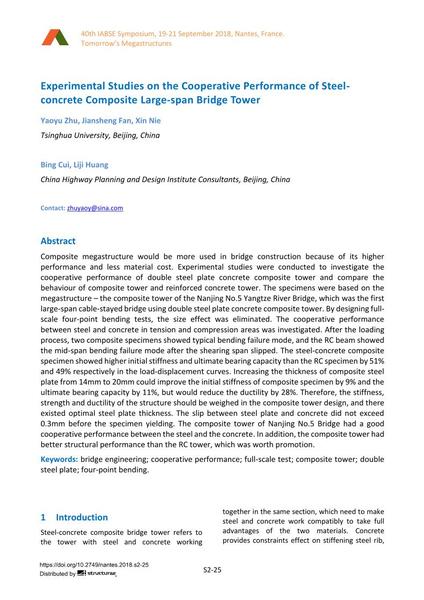Experimental Studies on the Cooperative Performance of Steel- concrete Composite Large-span Bridge Tower

|
|
|||||||||||
Bibliographic Details
| Author(s): |
Yaoyu Zhu
(Tsinghua University, Beijing, China)
Jiansheng Fan (Tsinghua University, Beijing, China) Xin Nie (Tsinghua University, Beijing, China) Bing Cui (China Highway Planning and Design Institute Consultants, Beijing, China) Liji Huang (China Highway Planning and Design Institute Consultants, Beijing, China) |
||||
|---|---|---|---|---|---|
| Medium: | conference paper | ||||
| Language(s): | English | ||||
| Conference: | IABSE Symposium: Tomorrow’s Megastructures, Nantes, France, 19-21 September 2018 | ||||
| Published in: | IABSE Symposium Nantes 2018 | ||||
|
|||||
| Page(s): | S2-25 | ||||
| Total no. of pages: | 8 | ||||
| DOI: | 10.2749/nantes.2018.s2-25 | ||||
| Abstract: |
Composite megastructure would be more used in bridge construction because of its higher performance and less material cost. Experimental studies were conducted to investigate the cooperative performance of double steel plate concrete composite tower and compare the behaviour of composite tower and reinforced concrete tower. The specimens were based on the megastructure – the composite tower of the Nanjing No.5 Yangtze River Bridge, which was the first large-span cable-stayed bridge using double steel plate concrete composite tower. By designing full- scale four-point bending tests, the size effect was eliminated. The cooperative performance between steel and concrete in tension and compression areas was investigated. After the loading process, two composite specimens showed typical bending failure mode, and the RC beam showed the mid-span bending failure mode after the shearing span slipped. The steel-concrete composite specimen showed higher initial stiffness and ultimate bearing capacity than the RC specimen by 51% and 49% respectively in the load-displacement curves. Increasing the thickness of composite steel plate from 14mm to 20mm could improve the initial stiffness of composite specimen by 9% and the ultimate bearing capacity by 11%, but would reduce the ductility by 28%. Therefore, the stiffness, strength and ductility of the structure should be weighed in the composite tower design, and there existed optimal steel plate thickness. The slip between steel plate and concrete did not exceed 0.3mm before the specimen yielding. The composite tower of Nanjing No.5 Bridge had a good cooperative performance between the steel and the concrete. In addition, the composite tower had better structural performance than the RC tower, which was worth promotion. |
||||
| Keywords: |
full-scale test bridge engineering cooperative performance composite tower double steel plate four-point bending
|
||||
